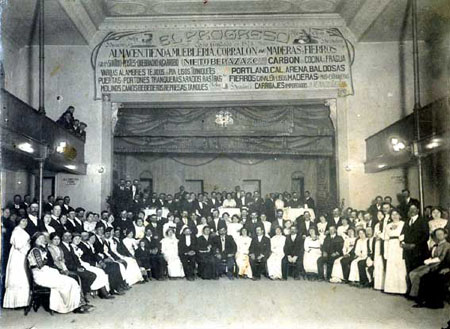| 
17 March 1918, St. Patrick's Day
in Venado Tuerto
(José Brendan Wallace collection) |
|
In
the Name
of Power
Culture and Place Names
in Venado Tuerto
Alejandra García
and Gladis J. Mignacco [1]
|
|
First
published in Spanish by Revista
Lote, Vol. VII, Nº 72 (Venado Tuerto, July
2003)
Translated by Lilian González Moore |
|
| The
negotiation of identities through the generation of connoted
place names seems to be a recurrent strategy of the South
American governing elites to align geographic spaces with
social and economic policies. Venado Tuerto, a city in
the Argentine province of Santa Fe founded by Eduardo
Casey in 1884, became an important settlement of Irish
and other immigrants. In order to provide an understanding
of the toponymic process, street names and their changes
from the last decades of the nineteenth century to the
1930s are identified and studied in this article within
the context of local and national social changes. Venado
Tuerto (the name) is associated with the frontier
land in the pampas, a place where the concept of Nation
was to be developed, and where the sense of community
was conceived step by step. Toponymy, a necessary complement
for the logoization of cartography (cf. Benedict
Anderson 1991), establishes the relationship between societies,
time, and place names. The link between the geographic
space and the perceived idea of frontier came from the
fact that urban people integrated themselves better to
the environment than the rural population. In a foundational
stage, toponymy represented the values of the immigrants.
The identification with an European ethos was
key to represent their opposition between civilisation
and barbarism. As a consequence, there was a cultural
supremacy of the Irish settlers. At a later phase, the
project of creating an Argentine identity gave preference
to the sense of ownership over other values. This included
the European immigration typical of the twentieth century.
The toponymy of Venado Tuerto streets is a sample representation
of these identification processes. |
|
| During
the settlement of the area around Venado Tuerto, toponymy
changed according to different historical, political,
social and cultural forces of the country and the city.
When we analyse those changes taking into account the
contributions of cultural geography, an unexpected local
history is revealed. Cultural geography help to research
the city streets’ toponymy through time, and provides
an understanding of continuities, changes and anomalies.
This research shows the place naming modalities from the
foundation of Venado Tuerto until the present time.
Streets
Names in Old and New Venado Tuerto
Does
the foundation of Venado Tuerto, its name, urban planning,
and street naming reveal the history and the geography
of the place? Were history and geography taken into account
during those fundamental processes?
| The
name Venado Tuerto was used from the beginning
of the nineteenth century to refer to that specific
geographic area. It is originated in a Mapuche toponym
that means ‘one-eyed deer.' [2] In fact, the name
was applied to a lagoon near the future city, which
was the point of reference and orientation, and provided
water to Indians and Europeans as well. As it was
customary, the name was associated with the memories
and events of the place, which later became real legends.
Venado Tuerto’s founder Eduardo Casey identified the
place with the name of the lagoon instead of using
his own name. In this way, he preserved the memory
of the space with its geographical characteristics.
He used the name Curumalán (also with Mapuche
roots) in another foundation. [3] |
|
Venado Tuerto
City in the south of Santa
Fe
province, Argentina,
department of General López, population 60,201 (172,359
in the department) according to 1991 census, 366 kilometres
from Buenos
Aires,
lat. 33° 46' S and long. 61° 48' W. Venado
Tuerto means 'one-eyed deer.' Some Irish-related
place names in the region include the following towns
and railway stations: Armstrong, Murphy, Duffy,
Hughes, Ham, and Cavanagh. |
|
|
| Notes
[1] Alejandra García (cavanaghgarciaa@enredes.com.ar),
Gladis J. Mignacco (ezquerro@powervt.com.ar),
Instituto Superior del Profesorado N° 7, Departamento
de Geografía.
[2] Landaburu, Roberto,
Irlandeses: Eduardo Casey, Vida y Obra (Venado
Tuerto, Santa Fe: Fondo Editorial Mutual Venado Tuerto,
1995).
|
|
| |
|
| ©
Alejandra García and Gladis J. Mignacco, Irish Argentine
Historical Society |
| Last
Update: July 2004 |
|
|
|

